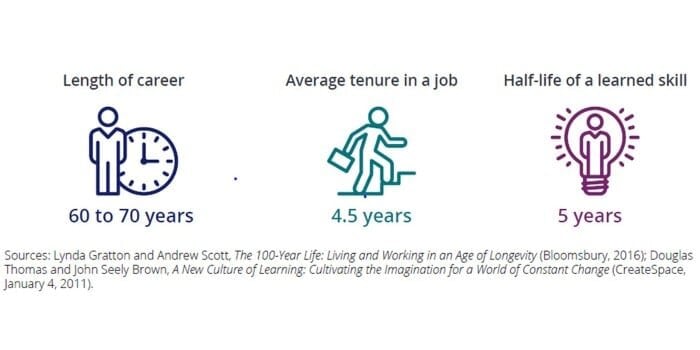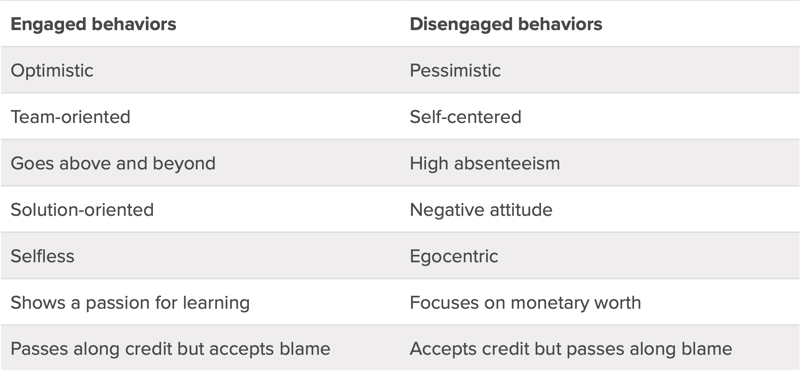7 Statistics That Highlight the Value of Continuous Learning
TABLE OF CONTENTS
Without a continuous learning program in place, a new joiner will soon become a disengaged member of your workforce.
From this point onwards they can either remain unengaged and continue to work for you, or churn.
As companies build the organization of the future, continuous learning is critical for business success.
‘Human Capital Trends’, Deloitte
The latter - churn - is unfavourable because of the associated cost. This entails the cost of replacement and the cost of wasted onboarding time and resources.
However having them stay on board is arguably worse. While you save the cost of churn in the short-term, their consistently low performance will disrupt your company’s trajectory to success in the long-term. Having disengaged employees is thought to cost the global workforce $7 trillion in lost productivity annually.
‘Actively disengaged’ employees aren’t harmlessly chugging along, but deliberately destabilising the success of engaged employees, and by extension, your business.
Every day, these workers potentially undermine what their engaged coworkers accomplish.
‘State of the Global Workplace’, Gallup
Conversely, there has been extensive research carried out on the connection between successfully executed learning initiatives, satisfied employees and favourable outcomes for employers.
But you don’t have to take our word for it - read on for the picture in numbers…
Employee turnover decreases
1. 94% of employees would stay at a company longer if it invested in their career development
The half-life of skills is decreasing. The half-life of skills used to be 10-15 years, it is now just 5. This means in 5 years time, the new skill you gained will be half as valuable as it was when you acquired it. And given the average career length is 60-70 years, this poses a problem.

When the rate at which you need to learn new skills in order to stay professionally competitive is rapidly increasing, it’s no wonder people are seeking employers that offer continuous learning.
In order for you to not lose new hires to competition, you need to offer a remedy to the ever-shortening skill half-life by providing learning opportunities in a consistent manner.
2. 40% of employees with poor training will leave the company within the first year
You can’t afford to take your foot off the pedal after hiring and onboarding. Existing employees require investing in with the same vigour that you invest in sourcing and onboarding employees in the first instance.
And the investment you make in your people through providing timely, regular learning opportunities will be returned tenfold in their productivity and output.
The more your people value the information you provide them with, and the more you provide this valuable information consistently, the longer they are likely to stay with you.
3. 86% of employees believe it’s important for employers to provide learning opportunities
The global workforce is undergoing a generational shift - by 2025 millennials will make up 75% of it. Millennials have a different set of expectations from their employers. 87% view development in a job as important, compared to just 69% of non-millennials.
They have fewer emotional ties and loyalty to workplaces than predecessors - if dissatisfied, they’ll move on.
Defined by their lack of attachment to institutions and traditions, millennials change jobs more often than other generations — more than half say they’re currently looking for a new job.
‘How Millennials Want to Work and Live’, Gallup
So to retain an increasingly millennial workforce, you need to adapt to their expectations, one of which is prioritising learning.
Engagement increases
4. People who work for companies that invest in resources for learning are 83% more likely to feel happier in their job
Happy employees are employees that are motivated, engaged, connected with company culture and feel as though they belong to a community. As a result they are more loyal and productive.
Unhappy employees are the antithesis - disconnected, unmotivated, unproductive and likely to churn.
5. 80% of people agreed learning new skills would make them more engaged
Yet only 56% actually are learning new skills. This exemplifies the mismatch occurring between what employees need from their employers in order to perform at their very best, and what they’re currently being given.

Employers are missing a trick. The business benefits of having an engaged workforce are huge - from 59% less turnover to a 10% increase in customer ratings and 20% increase in sales. All these micro benefits add up to the macro-benefit of 21% greater business profitability.
6. 46% of respondents said that the number one reason they feel bored at work is due to the lack of opportunity to learn
Interest in work is a key attribute of an engaged employee. While boredom doesn't necessarily signify disengagement, it is a warning signal of an employee’s potential to become chronically bored and permanently disengaged.
Disengaged employees are37% more likely to skip work, are 18% less productive and 15% less profitable.
Continuous learning staves off boredom because it puts people in a cycle of constant self-betterment.
Having to expand your skill set in an ongoing way creates the challenge of always working towards something new in an attempt to reach the next goal. This sense of challenge is motivating.
7. In an analysis of 3 million employee surveys, ‘learning and development opportunities’ were found to be the second most significant factor in determining engagement
It’s assumed compensation is top of employees’ list, and if sufficiently compensated an employee will be engaged, motivated and productive regardless of other influencing factors such as work-life balance, wellbeing and learning opportunities.
This is simply not the case.
In fact, when you deliver learning effectively, you tap into a more valuable form of employee motivation. This is because money is an extrinsic motivator - motivation derived from an external source, in pursuit of a reward.
But people are intrinsically motivated to learn, i.e. they do it for no other reason than that they want to. This is the more desirable form of motivation because it comes from within.
True motivation must come from within—it must be intrinsic. Prizes or awards (extrinsic) may bribe someone into performing a certain action but compliance is not motivation. If you want your group to be successful, intrinsic motivation must be infused into every aspect
‘Is Intrinsic Motivation Better Than Extrinsic Motivation?’, Elaine Clanton Harpine
Despite the overwhelming appetite for continuous learning, and the benefits incurred by both individuals and companies, LinkedIn’s Workplace Learning Report found talent developers spend just 15% of their time promoting employee engagement with learning.
The same report found that currently, only 46% of employees discover learning through managers or leadership. This is a hugely wasted opportunity considering 75% are enthusiastic to take manager-assigned courses.
The takeaway...
Once you’ve navigated the choppy seas of onboarding and have an engaged, motivated new joiner, to let their learning journey end there would be to undermine the time and cost put into an onboarding program.
It’s clear from the above that learning is valued by employees. More than this, when successfully executed, it decreases churn and bolsters motivation and engagement.
Having an engaged workforce is a pillar of Workforce Success - achieving the sustained success of the whole as a result of securing the success of every individual.
So if Workforce Success is the ultimate goal, and continuous learning is a means through which to achieve it, it’s crucial a companywide commitment is made to implement it.
Looking for a tool that will enable you to inform, engage, upskill, and crucially, deliver continuous learning to your workforce?
Want to watch a short video on how eduMe works? fill in the form below to see a pre-recorded demonstration 👇
Join 10,000+ frontline leaders
Subscribe to ‘Training the Frontline’ and get weekly insights sent straight to your inbox.




